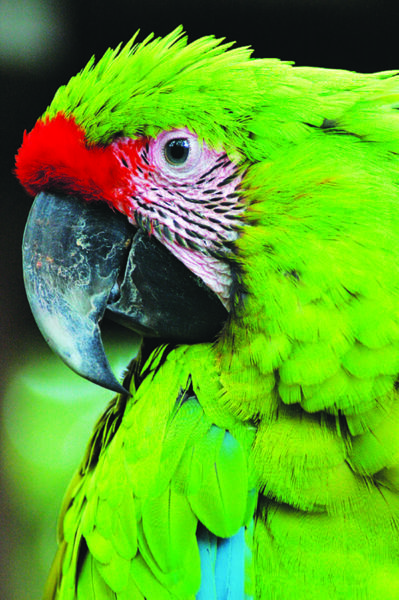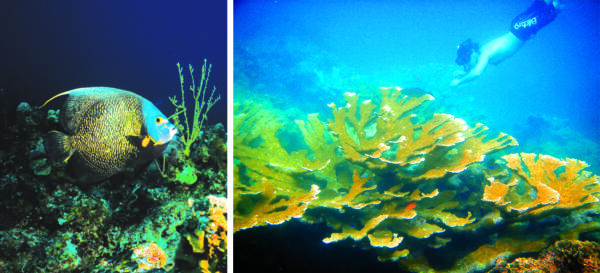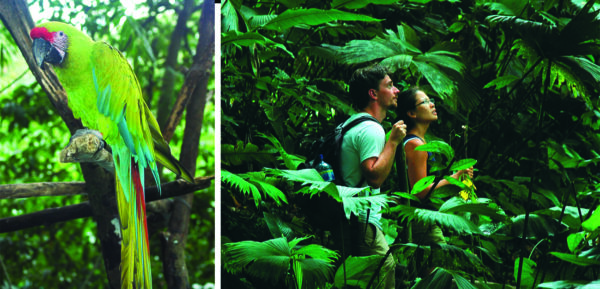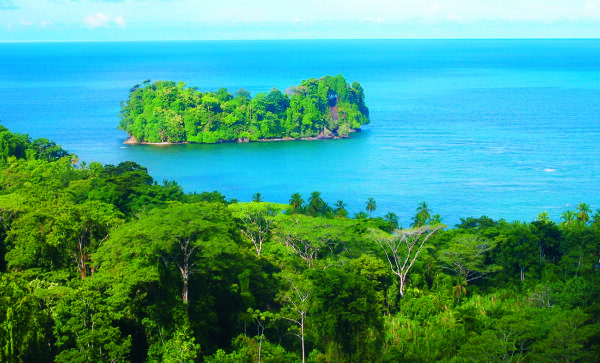
Gandoca-Manzanillo Refuge
Gandoca Manzanillo Reserve is one of the prettiest and most exuberant coastal areas of Costa Rica. It is located in the South Caribbean, province of Limon, and its littoral goes from Cocles beach, near Puerto Viejo, to Sixaola River, Panamanian border (map, page 34). The localities within the Reserve are Manzanillo and Gandoca, two Afro Caribbean towns.
The Reserve was created on the 29th of October 1985. 5,013 terrestrial has, and 4,436 marine has. are protected. In 1995 the Marshlands were declared of International Importance, becoming part of the RAMSAR Convention. The communities and the State manage it. Even though, 90% of their territory is in private hands. There is a management plan, which has the purpose of using the resources in the best possible way.

This remote and exotic place has a great diversity of terrestrial and marine habitats. Its terrestrial part is formed by small hills, with maximum altitudes of 115 meters, covered by rich tropical forest, primary forest in great part. In this forest the dominant species is the Cativo, a gigantic tree in danger of extinction. Other trees worth mentioning are almendro de montaña, cerillo, caobilla and dragon blood tree.

Inside the Reserve, between Manzanillo and Punta Mona there are 400 hectares of marshlands where you find species such as palma yolillo and orey trees. Coconut palm trees and beach almonds mainly form the coastal vegetation, whereas in the underbrush you find platanillas or heliconias.
The coast of the refuge is formed by beaches and coralline reefs. Between Manzanillo and Punta Mona you find a succession of emerged reef ends, which in some sectors rise up to 30 meters of height, among which you find small white sand beaches.

The coralline reefs are one of the most important ecosystems within the reserve, being one of the most beautiful and better conserved in the country. The reefs in front of Punta Uva, Manzanillo and Punta Mona cover an extension approximated 5 square kilometres, extending up to 200 meters offshore. In it you find various coral species, such as Diploria, Siderastrea, Agaricia, Acropora and Porites, as well as 34 molluscs species, 11 sponge species, 37 seaweed species, lobsters, Hawksbill sea turtle and a great variety of colourful tropical fish. In the marine bottom you find abundant turtle grass (Thalassia testudinum), forming shallow prairies.

Gandoca’s estuary is in the Southeastern end of the Reserve, where you have a lagoon with many mangroves, mainly the Red mangrove. Here you find a ostion bank, which is the reproduction and breeding place of numerous fish such as sábalo real and sometimes the manatees also visit the lagoon. Gandoca’s beach is the nesting place of the Leatherback sea turtle, the biggest one in the world, which are in danger of extinction as many other animals of the Reserve.

Gandoca – Manzanillo Reserve has various kinds of birds, around 350 bird species, of which 102 are migratory birds which come from the north of the continent. Among the local species the ones which standout most are toucans, great curassow, curré negro and the amazona frentirroja. Among the mammals you find three monkey species, the Howling, White-throated Capuchin and the Spider one, sloths, Jaguarundis and Ocelots. You also find caimans, green iguanas, poisonous red frogs and Black and Green Dart frogs, snakes and many insects. Dolphins are the ocean’s protagonists, where three species inhabit, the bottlenosed , the spotted and the small tucuxi, the smallest one in the world.

In order to visit the Reserve you will find two entrances or sectors, one by Manzanillo and the other one in Gandoca. In both places you find operational headquarters of the Environmental Ministry, where it is possible to obtain information or orientation on the local naturalistic guides, who offer their services in both towns. Long walks or boat trips are the best way to know this privileged area.
This protected area is one of Costa Rica’s natural wonders, a treasure to safeguard due to its extraordinary biological and landscaping richness. A task which into a great extent depends of the neighbouring communities and of the landowners within the Reserve limits, who must respect and guard for its conservation, while the State has to reinforce the control of its resources. This is the only way future generations and us will be able to enjoy the magic of this exuberant place.


Fotografías de Paco Salmerón
Texto de Juan Carlos Lorite y Paco Salmerón